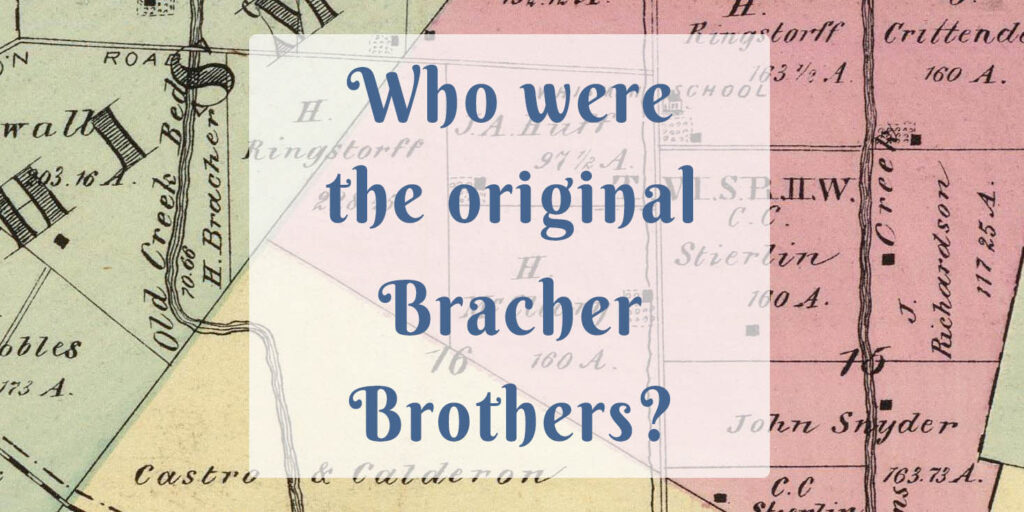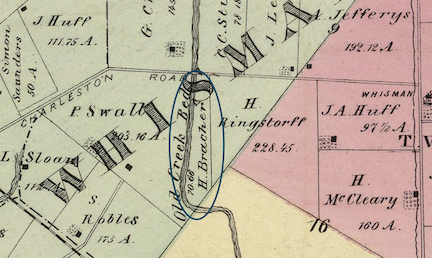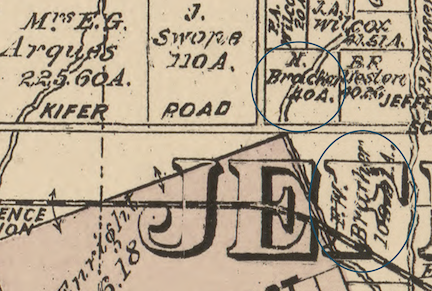
In Santa Clara County in close proximity to each other you will find both Bracher Elementary School and Bracher Park. According to the Santa Clara city website, the school was named for Karl E. Bracher, whose family had extensive orchard properties and operated the Bracher Fruit Company (originally Bracher Bros. Fruit Company).
But do you know the story of the original Bracher brothers from Germany and how they both ended up in Santa Clara County? I picked a random name to trace off a U.S. federal census record, and this is the story that I discovered. I haven’t talked to the family, but I would be interested to see how family stories interweave with the story that I pieced together using paper records.
Beginnings in Göppingen, Germany
Of the five children born to Friederich and Friederike “Reka” BRACHER, Herman Andreas (b. 1832) and Wilhelm (b. 1836) were the only two who lived beyond their first month. The family register from local church archives carefully notes births, deaths, and even the dates the brothers left for America.1

Their teen years in Göppingen, Germany (Kingdom of Württemberg) were marked by food scarcity and crop shortages. Hoping for a better future, just shy of his 18th birthday in 1850, Herman left for America. Sailing from Le Havre, France to New York in “steerage” aboard the packet ship Baltimore,2 his journey took approximately forty-two days. When Wilhelm turned 18, he followed his brother, sailing the same route from Le Havre to New York aboard the Isaac Bell.3
Things get a little hazy from here. Herman submits his naturalization petition in Illinois, but by 1859 he is in Santa Clara County, California. For Wilhelm it is different: the previously mentioned family register notes his return to Göppingen in July of 1863, his marriage in 1864, and the birth of many children.
Santa Clara County
In 1860, Herman is living in the Aviso area of San Jose. He marries in 1861, and by 1870 has four children. Throughout this time he works as a farmer: he owns horses, pigs and a milch cow, and produces butter and hay from his 70 acres of land. An 1876 map shows that his plot of land is just off Charleston Road,4 next to land owned by Henry Rengstorff—land where the modern-day Google complex sits.

Brothers reunited
In 1885, Wilhelm decides to join Herman in Santa Clara County. On 18 November 1885, Wilhelm, his wife and eight children (ranging from 15 years through 11 months) boarded the steamship Rugia, a ship whose between-decks has “ample accommodations for 1,000 immigrants…[and] a full complement of large life-boats.”5 Their journey lasts a mere 11 days, arriving into New York on 29 November 1885. In America, Wilhelm will be known as Frederick William.
With Wilhelm now in California, an 1889 map now shows Herman no longer owning his previous 70-acre lot. Instead, he and Wilhelm have adjacent plots, with Herman owning 40 acres and Wilhelm owning 100 acres on opposite sides of Kifer Road.6

When Herman passes away in 1892, the inventory of his estate listed 100 berry chests, 50 fruit boxes, fruit trays, and dried fruit, among other various farm implements. The contents of his estate show that his farm focused on producing the fruit and berries for which Santa Clara County became known. His brother Wilhelm passes away in 1907.
And that, folks, is the story of the original Bracher Brothers, without whom there would have been no Bracher Bros. Fruit Company. Karl E. Bracher, for whom Bracher Elementary was named, was one of the eight children of Wilhelm Bracher arriving in 1885.
Footnotes
1 Landeskirchliches Archiv Stuttgart. Family Registers of Göppingen. BRACHER, Michael Friedrich. 1808. Book 1, Band 39, p. 295. Img 290/507. Landeskirchliches Archive Stuttgart, Württemberg. Collection: Göppingen District, Göppingen. http://www.archion.de : accessed 15 March 2022.
2 Passenger List for the Baltimore arriving in New York from LeHavre. BRACHER, Herrm. 27 September 1850. Collection: New York, U.S., Arriving Passenger and Crew Lists (including Castle Garden and Ellis Island), 1820-1957. https://www.ancestry.com : accessed 15 March 2022.
3 Passenger list for the Isaac Bell arriving in New York from LeHavre. BRACHER, Wilhelm. 3 April 1854. Nr. 576. Img 11/13. Collection: New York, U.S., Arriving Passenger and Crew Lists (including Castle Garden and Ellis Island), 1820-1957. https://www.ancestry.com : accessed 16 March 2022.
4 Thompson & West. (1876) New historical atlas of Santa Clara Co. California. Sheet 1. 40 Chains to 1 inch. Collection: David Rumsey Historical Map Collection. Image No.: 2256008. San Francisco: Thompson & West. https://www.davidrumsey.com/luna/servlet/detail/RUMSEY~8~1~21650~660013:Santa-Clara-Co–1- : accessed 19 March 2022.
5 The New York Times. (1882) A New Steamship. Description of the Rugia of the Hamburg Mail Line. The New York Times. 8 December. p. 8b. https://www.newspapers.com : accessed 15 March 2022.
6 Britton & Rey—Herrmann Brothers. (1890) Official map of the County of Santa Clara, California : compiled from U.S. surveys, county records, and private surveys and the tax-list of 1889, by order of the Hon. Board of Supervisors. San Francisco: Britton & Rey. https://www.loc.gov/item/2012592102/ : accessed 24 March 2022.


